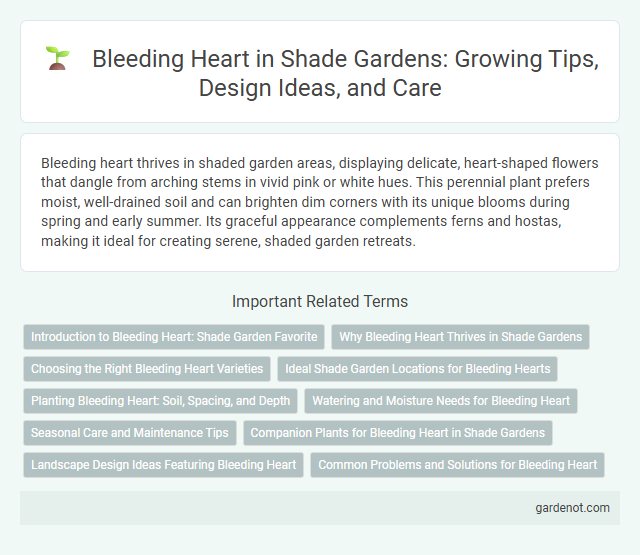Bleeding heart thrives in shaded garden areas, displaying delicate, heart-shaped flowers that dangle from arching stems in vivid pink or white hues. This perennial plant prefers moist, well-drained soil and can brighten dim corners with its unique blooms during spring and early summer. Its graceful appearance complements ferns and hostas, making it ideal for creating serene, shaded garden retreats.
Introduction to Bleeding Heart: Shade Garden Favorite
Bleeding heart (Dicentra spectabilis) thrives in shade gardens, prized for its delicate, heart-shaped pink or white flowers that bloom in spring and early summer. This perennial prefers well-drained, moist soil and partial to full shade, making it ideal for woodland garden settings or shaded borders. Its unique, arching stems and vibrant blooms add striking color and texture to shaded areas, enhancing garden biodiversity and aesthetic appeal.
Why Bleeding Heart Thrives in Shade Gardens
Bleeding heart (Dicentra spectabilis) thrives in shade gardens due to its preference for cool, moist, and well-drained soil conditions commonly found under tree canopies. Its delicate, fern-like foliage and unique heart-shaped flowers are adapted to low-light environments, allowing it to bloom abundantly in partial to full shade. This plant's natural habitat in woodland areas ensures it performs best in shaded garden beds where it avoids direct sunlight and heat stress.
Choosing the Right Bleeding Heart Varieties
Selecting the right bleeding heart varieties for shade gardens involves considering factors like flower color, plant size, and bloom time to suit specific garden conditions. Dicentra spectabilis is a classic choice with large pink and white heart-shaped flowers, while Dicentra eximia offers smaller, more delicate blooms and better heat tolerance. Opting for varieties such as Dicentra peregrina or Dicentra formosa can provide extended flowering periods and adaptability to various soil types, enhancing shade garden aesthetics.
Ideal Shade Garden Locations for Bleeding Hearts
Bleeding hearts (Dicentra spectabilis) thrive in ideal shade garden locations with partial to full shade and consistently moist, well-drained soil rich in organic matter. They perform best under the canopy of deciduous trees or alongside other shade-loving perennials like hostas and ferns, where they are protected from harsh afternoon sun. Garden areas with filtered sunlight and cool, humid conditions support vibrant blooms and healthy foliage throughout the growing season.
Planting Bleeding Heart: Soil, Spacing, and Depth
Bleeding heart thrives in well-drained, humus-rich soil with a slightly acidic to neutral pH between 6.0 and 7.0. Space plants about 1 to 2 feet apart to allow adequate air circulation and room for mature growth. Plant bleeding heart crowns 1 to 2 inches deep, ensuring the roots are fully covered while the crown remains just below the soil surface.
Watering and Moisture Needs for Bleeding Heart
Bleeding heart (Dicentra spectabilis) thrives in consistently moist, well-drained soil with regular watering to prevent the roots from drying out. It requires evenly moist conditions, especially during its active growing season in spring and early summer, but does not tolerate waterlogged soil. Mulching around the plant helps retain soil moisture and maintain the ideal humidity levels for healthy growth.
Seasonal Care and Maintenance Tips
Bleeding heart (Dicentra spectabilis) thrives in partial to full shade with well-drained, moist soil, requiring regular watering during dry spells to prevent wilting. After flowering in late spring, trim back the foliage once it yellows to encourage healthy dormancy through summer. Mulching helps retain soil moisture and protects roots from temperature fluctuations, supporting vigorous regrowth in the following season.
Companion Plants for Bleeding Heart in Shade Gardens
Hostas and ferns thrive alongside Bleeding Heart in shade gardens, enhancing moisture retention and creating a layered, textured understory. Astilbes complement Bleeding Heart by adding vibrant plume-like flowers and attracting pollinators that benefit the garden ecosystem. Toad lilies provide late-season interest with their intricate blooms, harmonizing well with the soft, arching stems of Bleeding Heart for continuous shade garden appeal.
Landscape Design Ideas Featuring Bleeding Heart
Bleeding heart (Dicentra spectabilis) thrives in shaded garden areas, offering delicate, heart-shaped pink or white flowers that create a romantic, ethereal atmosphere. Ideal for woodland gardens and shaded borders, bleeding heart pairs well with hostas, ferns, and astilbes, adding texture contrast and seasonal interest from spring to early summer. Incorporating bleeding heart into landscape design emphasizes a naturalistic aesthetic with graceful, arching stems that attract pollinators and enhance biodiversity in shady environments.
Common Problems and Solutions for Bleeding Heart
Bleeding heart (Dicentra spectabilis) often faces issues such as powdery mildew, aphid infestation, and root rot due to poor drainage. To prevent powdery mildew, ensure good air circulation and avoid overhead watering, while aphids can be controlled with insecticidal soap or neem oil. Improving soil drainage and avoiding waterlogged conditions help prevent root rot, promoting a healthy bleeding heart in shade garden settings.
Bleeding heart Infographic

 gardenot.com
gardenot.com